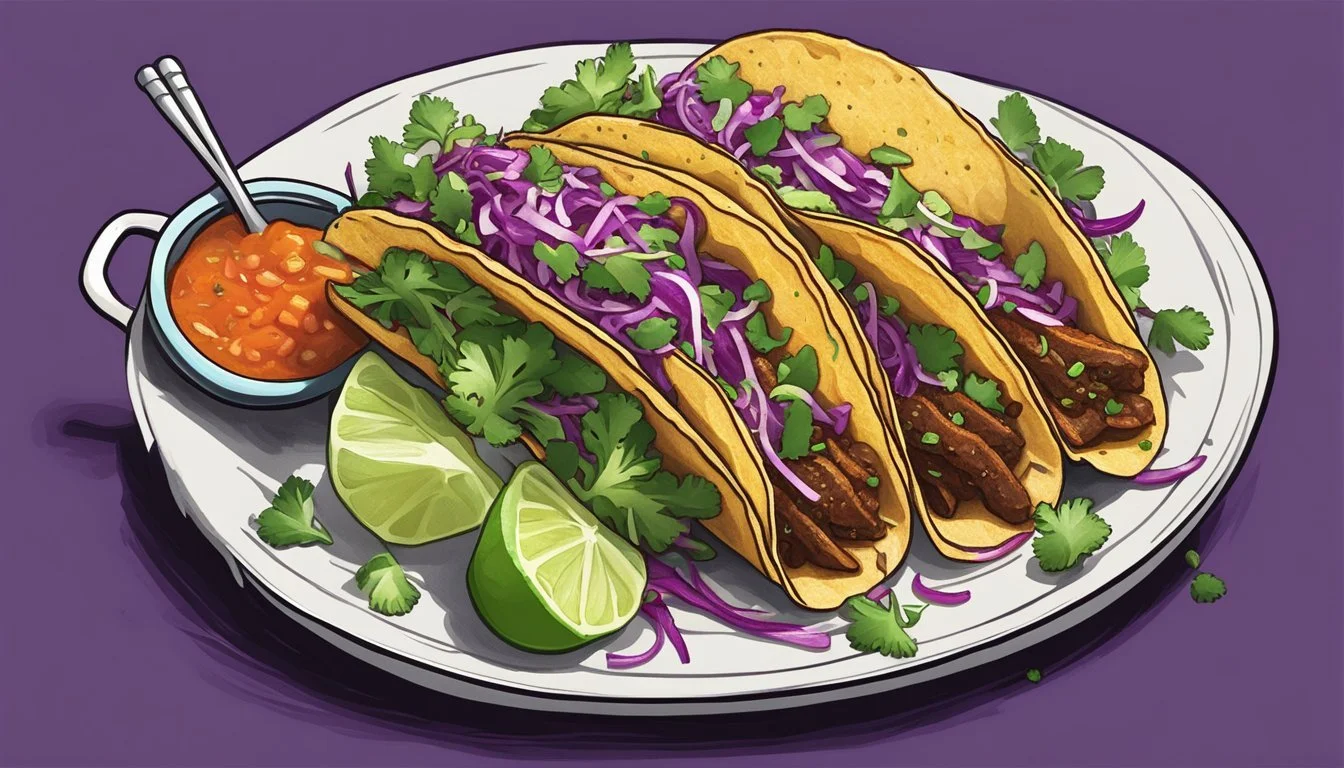Grasshopper Tacos
A Bold Twist on Traditional Mexican Street Food
Grasshopper tacos, known as tacos de chapulines in Mexico, represent a unique and flavorful facet of Mexican street food culture. Originating from the vibrant region of Oaxaca, these tacos challenge conventional western palates, offering a culinary experience that's rich in both tradition and taste. The main ingredient, chapulines, are grasshoppers that have been harvested, cleaned, and then typically toasted or fried. Seasoned with a blend of garlic, salt, chili, and a spritz of lime juice, these crunchy insects provide a distinct, yeasty flavor that's become a beloved treat among locals and a growing curiosity for food enthusiasts globally.
The concept of eating insects might seem novel to some, but it's a practice with deep roots in various cuisines worldwide, particularly in Oaxaca, where chapulines are an integral part of the gastronomic landscape. These flavorful grasshoppers are often found atop warm corn tortillas, complemented by traditional Mexican accompaniments such as salsas, onions, cheese, and guacamole. The tacos offer a burst of tangy and spicy flavors, encapsulating the essence of Mexican street food, where each bite is a testament to the region's rich culinary heritage and innovative spirit.
As street food, grasshopper tacos are not just a novelty; they present a sustainable source of protein that's environmentally friendly compared to traditional livestock. They cater to a diverse audience, from the daring food explorer to the environmentally conscious eater, all the while providing a taste of Mexican tradition that's as authentic as it is audacious. With their growing popularity, grasshopper tacos continue to leap beyond borders, inviting diners around the world to explore the bold flavors that Mexican cuisine has to offer.
Historical Significance of Grasshoppers in Mexican Cuisine
Grasshoppers, known as chapulines in Mexico, play a significant role in the nation's culinary history, particularly as a historical food source and a contemporary delicacy, with roots dating back to pre-Hispanic times.
Pre-Hispanic Roots
In Mexico, the consumption of grasshoppers dates back to the pre-Hispanic era, reflecting the country's rich indigenous heritage. These insects were not only a readily available protein source but also an integral part of the diet in regions where traditional livestock was less common. The indigenous people of Mexico, including the Aztecs, harvested chapulines as a reliable and sustainable food source from the fields.
Chapulines as a Delicacy
In contemporary Mexican cuisine, especially in Oaxaca, chapulines are considered a delicacy and a symbol of cultural identity. They are typically prepared by toasting them on a comal (a type of griddle) and seasoning them with garlic, lime, and salt containing extract of agave worms for added flavor. Oaxacan markets are known for their vibrant stalls where heaps of seasoned chapulines delight both locals and curious tourists. This delicacy is commonly served as a filling for tacos or as a standalone snack, often paired with mezcal or tequila, showcasing its versatility and enduring popularity.
The Making of Grasshopper Tacos
Grasshopper tacos, or tacos de chapulines, are an intriguing Mexican street food that combines traditional ingredients with the unique addition of fried grasshoppers. The process of making these tacos involves careful selection of ingredients, meticulous preparation of grasshoppers, and skillful assembly resulting in a flavorful experience.
Selecting Ingredients
Corn Tortillas: The foundation of tacos de chapulines is typically a warm, soft corn tortilla. In some regions, flour tortillas may be used, but corn tortillas are the classic choice, appreciated for their authentic flavor and texture.
Grasshoppers: The star ingredient, chapulines, must be sourced with care. They are often gathered from fields where they are abundant and then cleaned and prepared for cooking.
Flavorings: A mix of zesty lime juice, piquant chili powder, minced garlic, and finely chopped onions are crucial for seasoning the grasshoppers and adding layers of flavor.
Garnishes: Fresh cilantro leaves are commonly used to garnish the finished tacos, contributing a burst of herbaceous flavor.
Preparing Grasshoppers
Cleaning: The grasshoppers are thoroughly cleaned and then boiled or blanched to ensure safety and cleanliness before toasting or frying.
Seasoning: They are then traditionally seasoned with a combination of salt, garlic, and lime to enhance their natural flavor. Chili can be added for a spicy kick.
Cooking: The insects are toasted or fried to a crispy texture. It's important to cook them until they achieve a satisfying crunch, bringing out a nutty, yeasty flavor.
Assembling Tacos de Chapulines
Tortillas: Take a warm corn tortilla and hold it ready for the filling. Flour tortillas are an alternative option, though less traditional.
Filling: Spoon the seasoned, crisp grasshoppers onto the center of each tortilla.
Toppings: Add finely chopped onions and fresh cilantro to the grasshoppers for freshness and a balance of flavors.
Final Touches: Squeeze a wedge of lime over the grasshoppers, and sprinkle with additional chili as per taste preference before serving.
By following these steps, one can create a dish that captures the essence of Mexican street food culture, offering both familiarity and novelty to the palate.
Flavor Profile and Texture
Grasshopper tacos offer a unique blend of flavors and textures that are distinctive to Mexican street food. The savory taste of fried grasshoppers combined with traditional seasonings gives these tacos an unforgettable taste profile.
Balancing Taste
The flavor of grasshopper tacos is defined by a mix of bold seasonings and the earthy, nutty taste of the insects themselves. Lime juice adds a tart freshness that cuts through the richness, enhancing the overall savoriness of the taco. Chili powder contributes a slight heat which varies in intensity depending on regional recipes and personal preference, but it's always present to balance the zest of the lime.
Primary seasonings typically include:
Chili powder
Garlic
Citrus, notably lime juice
Seasoned grasshoppers, or chapulines, bring a yeasty undertone that melds with the aromatic garlic and the kick of chili, creating a harmonious taste.
Contrasting Textures
The texture of grasshopper tacos is an experience of contrasts. Fried grasshoppers provide a crunchy bite that is the hallmark of this dish. They are often nestled in a soft, warm corn tortilla, allowing for a combination of textures in each bite.
Texture combination in a grasshopper taco:
Crispy grasshoppers
Soft tortillas
Additional toppings like diced onions adding a fresh crunch
When one adds onions to the taco, they complement the crispiness with their own fresh, crisp texture and a sweet sharpness that contrasts with the deep-fried grasshoppers. The juxtaposition of crunchy insects and soft tortillas makes for an eating experience that is as interesting in texture as it is rich in flavor.
Nutritional Value
Grasshopper tacos, traditionally known as "chapulines" in Mexican cuisine, are not only a culinary delight but also a source of high-quality nutrition. They offer a sustainable and nutrient-rich alternative to conventional meats.
Insects as a Protein Source
Insects, particularly grasshoppers, are an excellent source of protein. They provide all nine essential amino acids, making them a complete protein source. Here are the specific nutritional benefits of grasshoppers:
Protein Content: Grasshoppers are composed of up to 60-70% protein by dry weight, which is comparable to or even higher than traditional meats.
Comparison of Protein Content (per 100g):
Grasshoppers: 60-70g of protein
Beef: 26-27g of protein
Chicken: 23-25g of protein
Fat Content: They contain a healthy ratio of unsaturated fats, which are beneficial for heart health.
Vitamin and Mineral Rich: Grasshoppers are rich in B vitamins, iron, magnesium, zinc, and calcium, all of which are critical for maintaining various body functions.
Fiber: Unlike conventional meat sources, insects contain chitin, a source of dietary fiber.
Considering these points, it's clear that grasshopper tacos offer a nutritious and high-protein food choice. They provide a way to incorporate sustainable protein into diets, potentially reducing the ecological footprint of food consumption without sacrificing nutritional value.
Serving and Pairing
When serving Grasshopper Tacos, one should consider the traditional side dishes that complement the complex flavors. Including popular condiments and suitable beverages can greatly enhance the dining experience.
Traditional Side Dishes
In Mexican cuisine, Grasshopper Tacos are often accompanied by a variety of side dishes that balance out the meal. These side dishes usually consist of:
Rice: A staple offering, often seasoned with tomato and aromatic spices.
Beans: Refried or whole black beans provide a creamy, earthy component.
Harmony on the plate is achieved when the simplicity of these side dishes contrasts with the depth of the Grasshopper Tacos.
Popular Condiments
A selection of condiments allows diners to customize their taco experience. The most popular ones include:
Salsa: Fresh or roasted tomato salsa adds a juicy, tangy kick.
Guacamole: Creamy avocado-based guacamole brings coolness and richness.
Cheese: A sprinkle of Cotija cheese lends a salty, crumbly texture.
Lime: A squeeze of lime juice is essential for its bright acidity.
These condiments add layers of flavor and texture to each bite, making the tacos a truly sensory experience.
Beverage Complements
Choosing the right beverage to accompany Grasshopper Tacos can round out the flavors. Traditional beverages include:
Beer: A light Mexican lager cuts through the savory notes of the tacos.
Agua Fresca: Fruit-infused waters offer a sweet counterpoint.
The effervescence of beer or the sweetness of an Agua Fresca refreshes the palate between bites of richly flavored tacos.
Cultural and Street Food Scene
In Mexico, the street food scene is renowned for its rich flavors and diversity, with grasshopper tacos, known as "chapulines" in Spanish, featuring prominently in Oaxaca's culinary landscape.
Grasshopper Tacos in Oaxacan Street Food
Oaxaca is celebrated for its diverse cuisine, including the distinctive grasshopper tacos that are a staple in the region. These tacos are made with locally sourced chapulines, which are toasted grasshoppers seasoned with garlic, lime, and salt, often accented with a hint of chili. Served in small tortillas, they offer a crunchy, umami-packed experience that reflects Oaxaca's bold approach to traditional flavors and its commitment to utilizing indigenous ingredients.
Key Ingredients: Toasted chapulines, garlic, lime, salt, chili
Serving: Small tortillas
Vendors and Taco Trucks
The proliferation of vendors and taco trucks across cities like Oaxaca and Puebla exemplifies the accessibility and enduring popularity of Mexican street tacos. Whether set up in permanent spots or on the move, these purveyors are part of the social and culinary fabric of the nation. Taco trucks especially offer a convenient way to taste a variety of Mexican street foods, each with its own regional twist.
Locations: Streets of Oaxaca and Puebla
Offerings: Variety of Mexican street foods including grasshopper tacos
Vendors harness the power of traditional cooking methods to deliver authentic flavors, ensuring that each grasshopper taco eaten on the streets of Oaxaca or from a taco truck in Puebla is a genuine taste of Mexican heritage.
Recipe Variations
When it comes to Grasshopper Tacos, diners and chefs alike relish in the opportunity to infuse traditional fare with creative flourishes. Whether accommodating personal tastes or dietary requirements, the variations are as vast as the imagination.
Modern Twists
Chefs are continually pushing the culinary envelope by adding innovative ingredients to the classic Grasshopper Taco recipe. Some opt for a grilled version of the taco, providing a smoky flavor that complements the inherent nuttiness of the grasshoppers. Savory elements like garlic aioli or mango salsa can enhance the dish's complexity, while others might introduce a hint of sweetness with a pineapple-chipotle sauce. For a truly modern spin, one might serve the taco on a miniature blini instead of a corn tortilla, garnishing it with microgreens.
Grilled Grasshopper: Adds a smoky nuance
Sauces and Salsas: Garlic aioli, mango salsa, or pineapple-chipotle sauce for depth
Adaptations for Dietary Restrictions
Grasshopper Tacos can also be modified to accommodate various dietary restrictions. For those following a gluten-free diet, using corn tortillas is a natural choice, staying true to Mexican culinary roots while ensuring the meal is accessible to all. Dairy-free versions might substitute traditional cheese toppings with nutritional yeast or a vegan cheese alternative. To bolster nutritional content, chefs might add a scoop of guacamole for healthy fats or a sprinkle of quinoa for extra protein.
Gluten-Free Options: Corn tortillas instead of flour
Dairy-Free Alternatives: Nutritional yeast or vegan cheeses
These variations not only cater to individual dietary needs but also contribute to the evolving landscape of modern Mexican street food.
Incorporating Grasshoppers into Other Mexican Dishes
Grasshoppers, or chapulines, are a versatile ingredient in Mexican cuisine, bringing a unique flavor and texture to a variety of dishes beyond classic tacos.
Beyond Tacos: Chapulines in Other Recipes
Tlayudas: Chapulines can add a delightful crunch and flavor when sprinkled atop a tlayuda, a traditional Oaxacan dish consisting of a large, crispy tortilla smothered with asiento (unrefined pork lard), beans, cheese, and lettuce.
Tlacoyos: These oval-shaped corn dough cakes are often stuffed with beans, cheese, or other fillings. By incorporating chapulines, chefs add a protein-rich component that complements the earthy flavors of the tlacoyo.
Tamales: Grasshoppers can be mixed into the dough or used as a filling for tamales, providing a textural contrast to the soft masa and adding a savory note to each bite.
Quesadillas: A quesadilla filled with cheese and chapulines offers a simple yet satisfying combination, with the toasted grasshoppers bringing both a nutty taste and a boost of protein.
Conclusion
Grasshopper tacos, known in Mexico as tacos de chapulines, stand as a testament to Mexico’s rich culinary diversity and willingness to embrace unconventional ingredients. They offer a unique dining experience that reflects the adventurous spirit of Mexican street food culture. One can appreciate grasshopper tacos as a delicious and sustainable source of protein, differentiated by their distinctive crunch and the earthy, umami flavor they contribute to each bite.
In Oaxaca and other parts of Mexico, these tacos are more than a novelty; they are a delicacy steeped in tradition. The practice of harvesting and preparing chapulines involves toasting or frying the grasshoppers and enhancing them with local spices like garlic, chili, and lime. This careful preparation imbues the grasshoppers with a flavor profile that is complex and pleasing to the palate.
Mexican street food enthusiasts enjoy chapulines as a snack or filling for tacos, often highlighting the culinary creativity that characterizes Mexican cuisine. The sustainable aspect of consuming grasshoppers, which require far fewer resources to farm than traditional livestock, offers a forward-thinking approach to food consumption.
Tacos de chapulines are an example of how traditional foods can reframe perceptions and gain international interest. They invite diners from around the world to explore the diversity and innovation within Mexican gastronomy. Those seeking an authentic taste of Mexico will find grasshopper tacos a flavorful journey into the country’s culinary heart.
Embracing the unexpected is part and parcel of experiencing the true essence of Mexican street food, and grasshopper tacos perfectly encapsulate this spirited discovery. They are a delightful representation of Mexico's commitment to flavor, tradition, and gastronomic exploration.






